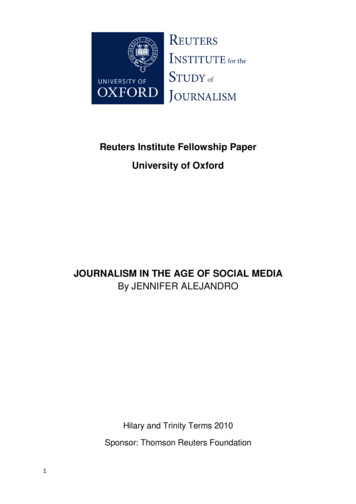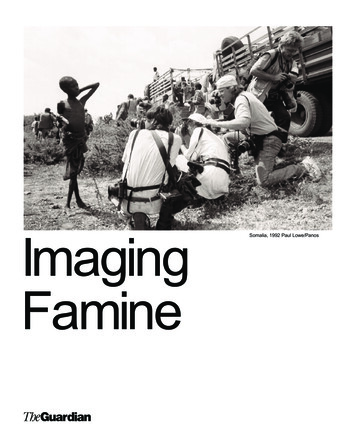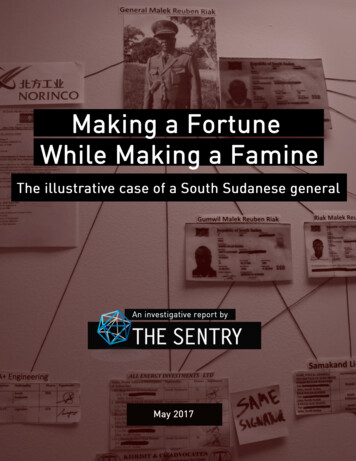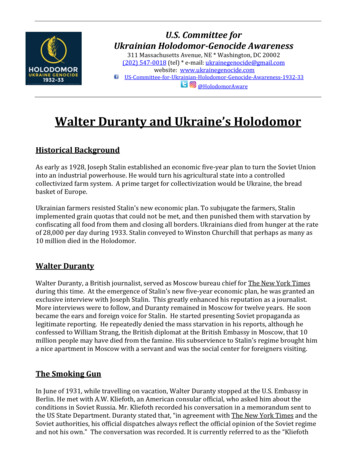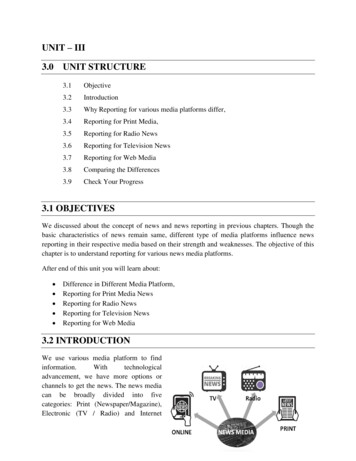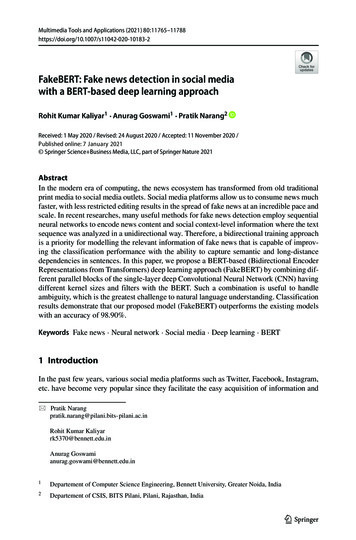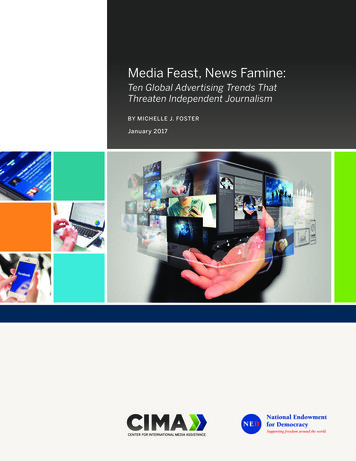
Transcription
Media Feast, News Famine:Ten Global Advertising Trends ThatThreaten Independent JournalismBY MICHELLE J. FOSTERJanuary 2017
Media Feast, News Famine:Ten Global Advertising Trends ThatThreaten Independent JournalismJANUARY 2017ABOUT CIMAThe Center for International Media Assistance(CIMA), at the National Endowment for Democracy,works to strengthen the support, raise the visibility,and improve the effectiveness of independentmedia development throughout the world. Thecenter provides information, builds networks,conducts research, and highlights the indispensablerole independent media play in the creation anddevelopment of sustainable democracies. Animportant aspect of CIMA’s work is to research waysto attract additional U.S. private sector interest inand support for international media development.CIMA convenes working groups, discussions, andpanels on a variety of topics in the field of mediadevelopment and assistance. The center also issuesreports and recommendations based on workinggroup discussions and other investigations. Thesereports aim to provide policymakers, as well asdonors and practitioners, with ideas for bolsteringthe effectiveness of media assistance.Center for International Media AssistanceNational Endowment for Democracy1025 F STREET, N.W., 8TH FLOORWASHINGTON, DC 20004PHONE: (202) 378-9700FAX: (202) 378-9407EMAIL: CIMA@ned.orgURL: http://cima.ned.orgMark NelsonSENIOR DIRECTORADVISORY COUNCIL FOR THE CENTER FORINTERNATIONAL MEDIA ASSISTANCEStephen Fuzesi, Jr.William A. GalstonSuzanne GarmentEllen HumeJerry HymanAlex S. JonesShanthi KalathilSusan KingCraig LaMayWilliam OrmeDale PeskinAdam Clayton Powell IIIMonroe E. PriceRep. Adam SchiffMarguerite SullivanRichard WinfieldContentsIntroduction. . . . . . . . . . . . . . . . . . . . . . . . . . . . . . . . . . . . . 1Ten Factors Affecting Independent News Media . . . . . . 3How News Outlets in the Are Performingin the Digital Advertising Market . . . . . . . . . . . . . . . . . . 17Charting a Course: How Independent MediaCan Improve Digital Distribution. . . . . . . . . . . . . . . . . . . 22Endnotes . . . . . . . . . . . . . . . . . . . . . . . . . . . . . . . . . . . . . . 24ABOUT THE AUTHORMichelle J. Foster is a media management andmarketing consultant who helps news mediacompanies to improve business performance. Fosterserves on the board of the Independent JournalismFoundation and has worked with organizationsthroughout the United States and in China, Burma,Southeast Asia, the Balkans, Eastern Europe andAfrica. She has been a Knight International Journalism Fellow inSoutheast Asia on two occasions. From 1991 until 2003, Foster wasthe senior market development executive for Gannett Co., Inc.’sNewspaper Division. As such, she oversaw marketing efforts for97 daily newspapers, a host of national brands, and niche productlines. Foster has also researched and written project proposalsfor international media projects and conducted monitoring andevaluation of such programs. She has co-developed an e-learningplatform enabling a partner organization to deliver training tomedia managers and journalists operating in conflict areas, underrepression, or in exile. She has authored a number of reports ontopics related to media development, including several overviewsof the business environment for news media in Burma during thecountry’s transition.
IntroductionWhen global media brands and digital social media platforms entermarkets, especially markets with little indigenous media capacity,they can greatly expand the amount of news and entertainment forcitizens. The entire market for media expands—but not without a cost. Nationaland local news is increasingly a casualty of globalized media markets.Al-Jazeera’s international expansion, Facebook’s growing importanceto citizens in the Global South, Disney Channel Worldwide’s farreaching distribution network: these platforms and others have broughtaudiences around the world more content than ever. But these platformsalso bring with them a restructuring of advertising markets that can ymgerman/Shutterstockfavor government-funded state media or entertainment platforms oversmaller outlets offering national and local news. Simultaneously, theubiquity of mobile platforms has made them key vectors for transmittingnews in real time using social media. In countries with otherwise limitedmedia channels, mobile plays a dominant role. 1 Facebook, WeChat,and others are leading channels for distributing news, user-createdcontent, and commentary. While this has many positive outcomes, italso facilitates the spread of pro-government messaging, propaganda,misdirection, and hate speech. 2 Moreover, when independent newscontent appears on social media platforms, it is often the platformthat harvests the revenue, not the content provider, further eroding thefinancial base for local and national reporting.Often vulnerable are the independent news media operating inrestrictive environments, along borders of closed countries, or inexile. Similarly, they are often the least-resourced news providers andIn countries with otherwiselimited media channels,mobile plays a dominantrole. Facebook, WeChat,and others are leadingchannels for distributingnews, user-created content,and commenting.exist outside of mainstream advertising marketplaces. Internally, theyfrequently lack the data to make good decisions about matching contentto audiences and—focused on their social missions—may lack the will ormotivation to do so. Yet the failure to engage with broad audiences on aregular basis shuts them off from sources of revenue.Thus, in a world where people can feast on an unlimited buffet ofmedia choices, there is an increasing famine of credible, thorough, andindependent nationally-focused news reporting. The former masks thelatter as people worldwide now have access to an unlimited amount ofentertainment through a wide variety of channels and as governmentsexert more comprehensive and nuanced control over media. Betterconnected globally, but less informed locally, citizens living in theseM e d i a Fe a s t , N e w s Fa m i n e : Te n G l o b a l A d ve r t i s i n g Tre n d s T h a t T h re a t e n I n d e p e n d e n t J o u r n a l i s m#mediadev1
media environments may not recognize when their rights to be informedabout their government and their society are being compromised.This report looks at ten factors that have altered the media marketplaceand that pose challenges to national and local news producers and theirsources of revenue. They include ways in which governments interferein media markets; changes in the structure of news distribution andaudience behavior; and the way these changes have transformed howadvertising media is bought, sold, and distributed. It then examines thekey engagement metrics taken from a sampling of media developmentpartner organizations to offer thoughts on how well these newsproducers are prepared to compete for audiences and revenue. Finally,it offers thoughts about the implications of these issues for mediadevelopment organizations.2C E N T E R F O R I N T E R N AT I O N A L M E D I A A S S I S TA N C EC I M A . N E D.O R G
Ten Factors Affecting Independent News MediaIndependent media are capturedand replaced with entertainmentFACTOR #1Around the world, there has been a marked deterioration in press freedomsin recent years, threatening the survival of independent news coverage insome areas. Reporters Without Borders cites a number of risks to pressfreedom in the most recent World Press Freedom Index, some old and somenew. Journalists continue to be attacked and murdered for their work andcharged for spurious crimes such as “insulting the president” or “blasphemy,”while several governments have reasserted controls on state-owned media.Armed conflict, the spread of ideologies hostile towards journalism, anddeteriorating security situations in numerous countries have also threatenedthe ability of journalists to perform their professional duties. 3Simultaneously, independent journalism faces more sophisticatedtechniques of suppression. Taking advantage of the challenge to journalisticbusiness models created by digital media, authoritarian states are buildingnew, modern-day propaganda machines. Meanwhile, “throughout theworld, ‘oligarchs’ are buying up media outlets and are exercising pressurethat compounds the pressure already coming from governments.” 4 Thesecombined forces lead to a capture of media that distorts the entire medialandscape “where political leaders and media owners work together in asymbiotic but mutually corrupting relationship.” 5Captured media does not have the same complexion as Soviet-styleTaking advantage of thechallenge to journalisticbusiness models createdby digital media,authoritarian states arebuilding new, modern-daypropaganda machinescensorship; on the contrary, captured media often dazzle audiences withhigh-quality entertainment and even with glossy news productions—butwith an emphasis on the sensational and scandalous, and without thecritical content citizens need to hold their governments to account.Unfortunately, there are many examples.In Serbia, the recent privatization process resulted in the capture andconsolidation of more media. It fueled the rise of entertainment and realityprogramming at the expense of journalism. Minority and independentprovincial media became starved for revenue. B92, the bold independentradio station known for its opposition to Slobodan Milošević, retreatedfrom its critical position and changed to an entertainment format. Themedia sector in 2015 was “characterized by the collapse of law, ethics,professionalism, and social norms.” 6In Turkey, dramatic changes in the ownership of media organizations have allbut eliminated senior figures in the news industry who are willing to publishstories critical of the ruling government. The results of this capture was laidM e d i a Fe a s t , N e w s Fa m i n e : Te n G l o b a l A d ve r t i s i n g Tre n d s T h a t T h re a t e n I n d e p e n d e n t J o u r n a l i s m#mediadev3
bare in October 2011, when then Prime Minister Recep Tayyip Erdogan (nowPresident) summoned a group of 35 senior media figures to orchestrate thecensorship of news about a cross-border attack by the Kurdistan WorkersParty from Iraq. The attendees obliged the request without any resistance,according to an account of the gathering that was later published by one ofthe few openly critical newspapers.7Both China and Russia have actively limited access to journalism (whetherby censorship or economic pressure) while serving up a vast assortment ofpolitically encoded entertainment media that has high-quality productionvalues and compelling content.In February 2016, Chinese President Xi Jinping toured the country’smajor newsrooms telling reporters and editors in no uncertain terms thattheir job, first and foremost, is to serve the Party. A subsequent editorialin Xinhua noted “according to Xi, managing journalism and publicity is‘crucial for the Party’s path, the implementation of Party theories andpolicies, the development of various Party and state causes, the unity ofthe Party, the country and people of all ethnic groups, as well as the futureand fate of the Party and the country.’” 8In February 2016, ChinesePresident Xi Jinpingtoured the country’smajor newsrooms tellingreporters and editors in nouncertain terms that theirjob, first and foremost, isto serve the Party.And now both China and Russia are making efforts to extend theirinfluence over media outside their borders.For example, the Chinese government has made tremendous effortsto influence global media through a combination of market-orientedmechanisms, propaganda and pressure tactics. 9 Chunwan, the annualprogram celebrating the eve of the Spring Festival, reaches an estimated900 million viewers worldwide. China Central Television (CCTV) has builta vast and well-funded news network around the world with more than 70international bureaus, including major global offices in Beijing, Nairobi andWashington, DC. Broadcasting in local languages as well as Chinese, CCTVhas hired reputable journalists to provide independent coverage, but witheditorial limits imposed on stories with political relevance to China. 10In the Russian language space, Kremlin-aligned media, includingthose owned by commercial entities, dominate. Their Moscow-centricprogramming offers high production values, prolific choices, narrativesthat evoke nostalgia for the Soviet past, and anti-Western viewpoints. Talkshows and reality shows feature wildly popular stars. Shows focusing onRussia’s role and perceived victimization during World War II are common.More than 850 sitcom series (not individual shows, but entire multiepisode series) were produced during 2015. 11In aggregate, these moves both limit audience access to national andlocal news reporting while concealing the absence with an abundance ofother content. Ross Settles, an expert on digital media and consultant for4C E N T E R F O R I N T E R N AT I O N A L M E D I A A S S I S TA N C EC I M A . N E D.O R G
the Media Development Investment Fund (MDIF), worries that audiencesin these environments “may not be able to distinguish between qualityjournalism and good production values.” 12FACTOR #2 Many audiences haveswitched to digital, especially on mobileThese ramped-up efforts by governments to promoteMobile-Cellular Subscriptionsself-serving agendas and limit access to independentPER 100 INHABITANTSand factual reporting are occurring at the same timethat major secular changes are reshaping how audiencesGermanyJapan120consume media, and how journalism is funded—with theKorea (Rep.)continued viability of advertising as the key source ofrevenue for news media coming into question.100Most significant in the growth of digital media is theChinanear ubiquitous presence of mobile, even in countriesNepalBhutanZambiaAfghanistanYemenLao P.D.R.Sierra LeoneTimor-Leste80that otherwise have limited Internet access. Mobilehas become the fasting growing platform in terms of60audience use, especially in regions where its use hasleapfrogged laptop or desktop Internet connectivity.SomaliaThere is ample evidence of how, where, and whenCongo (Dem. Rep.)40audiences use media, including the rise of social mediaDjiboutiEthiopiaas a preferred news channel.20Pew’s State of the News Media 2016 takes an in-depthlook at audience behavior in the United States. 13EritreaReuters Institute for the Study of Journalism produces0its annual Digital News Report that examines current1995issues affecting news media. 14 Mary Meeker’s annualan organization representing the interests of mobileoperators worldwide, shares deep data on mobile useand the relative connectivity of countries through itsGMSA Intelligence site. 1620052010SOURCE: International Telecommunication Union 18report on Internet trends provides powerful insightsinto the trends surrounding digital media. 15 GSMA,2000Mobile has become the fasting growingplatform in terms of audience use, especiallyin regions where its use has leapfroggedlaptop or desktop Internet connectivity.The International Telecommunication Union (ITU), the United Nations’agency dedicated to gathering data on information and communicationissues, reports that seven billion people, or 95 percent of the world’spopulation, live in an area covered by one or more mobile networks andthat more than half of the world’s population has a mobile phone. Even inleast developed countries, which still lag their more developed counterparts,mobile penetration has grown rapidly during the last five years.17M e d i a Fe a s t , N e w s Fa m i n e : Te n G l o b a l A d ve r t i s i n g Tre n d s T h a t T h re a t e n I n d e p e n d e n t J o u r n a l i s m#mediadev5
FACTOR #3 Mobile penetration is settingthe conditions for an even greater shiftThat said, mobile phone penetration is not a proxy for Internet penetration,but it is often its forerunner, and the potential for an even greater shift byaudiences to digital is enormous.ITU’s data show that “by the end of 2016, more than half of the world’spopulation—3.9 billion people—will not yet be using the Internet. Figuresfor household access reveal the extent to which this digital divideremains geographical: 84 percent of households are connected in Europe,compared with 15.4 percent in the African region.” 19Percentage of households with Internet Access83.867.8SOURCE: International Telecommunication Union, ICT Fact and Figures 2016LDCsWorld15.4Developing41.1DevelopedAsia & PacificArab StatesCISThe Americas52.346.445.7Africa64.4EuropeAlmost one billion householdsin the world have internetaccess, of which 230 millionare in China, 60 million inIndia and 20 million in theworld’s 48 LDCs84.0PERCENTAlmost two-thirds ofhouseholds in the Americasare connected compared withhalf of all households globally.11.120World’s Offline Population, 2016MORE THAN HALF THE WORLD’S POPULATION IS NOT USING THE INTERNETCIS33.4%Europe20.9%Percentage ofindividuals NOTusing the InternetAsia & Pacific35.0%Africa74.9%26–5051–75Arab States58.4%SOURCE: International Telecommunication Union, ICT Fact and Figures 201660–2558.1%The Americas76–10021C E N T E R F O R I N T E R N AT I O N A L M E D I A A S S I S TA N C EC I M A . N E D.O R G
When mapped, the differences in Internet access between the Global Northand South are apparent. But while such inequalities in Internet penetrationare indeed a reminder that the trends highlighted in this report haveoccurred unevenly, the remaining inequalities can also be viewed as the Rob Crandell/Shutterstockpotential for these trends to spread and intensify. The Free Basics programcurrently being piloted in Nigeria by Facebook suggests that the Internetgiant, for one, sees the digital divide as more of an opportunity than anobstacle. Free Basics aims to be a Facebook-centric, stripped down versionof the Internet made available at no charge through partnerships with mobileservice providers. The Free Basics service has been criticized elsewherefor providing a platform that could be easily controlled by authoritarianThe Free Basics programcurrently being piloted inNigeria by Facebook hasbeen criticized elsewherefor providing a platformthat could be easilycontrolled by authoritariangovernments.governments,22 but if initiatives such as Free Basics succeed in expeditingthe shift to digital media in these areas, local news producers may merely besuppressed by the dynamics of the digital advertising market.It is an often overlooked fact that in areas where Internet access is limited,or where newspapers exist in vernacular languages, newspaper circulationhas increased in recent years. The largest gains have occurred in Asia,primarily in India and China, followed by more modest increases in Africaand Latin America. WAN-IFRA succinctly summarizes its data with thedeclaration that “Print circulation rises in East, sets in West,” and notesthat increased literacy and economic growth in those areas have fueledits expansion. 23 Whether these bright spots of growth in national and localnews media can be sustained, however, may depend on whether mediahouses are prepared for, or somehow protected from, the disruptive effectsof the shift to digital and mobile.Daily Print Newspaper Circulation Change by Region40%32.7%30%5 YEARS20%1 aNorthAmericaAfrica &MENALatinAmericaAustralia &OceaniaSOURCE: WAN-IFRA World Press Trends 2015M e d i a Fe a s t , N e w s Fa m i n e : Te n G l o b a l A d ve r t i s i n g Tre n d s T h a t T h re a t e n I n d e p e n d e n t J o u r n a l i s m#mediadev7
FACTOR #4 Advertising revenueshave followed audiencesWhile television has long been the primary advertising vehicle worldwide,Zenith Optimedia, which tracks annual global and regional advertisingspending by medium, forecasts that Internet advertising revenue (desktopplus mobile combined) is expected to surpass the amount spent ontelevision during 2017.Of total global advertising expenditures of 579 billion in 2016, Internetadvertising was the main source of growth. Internet advertising, ondesktops and mobile devices, is growing three times faster than advertisingon other media channels, increasing 15.7 percent in 2016 fueled byincreases in social media (31.9 percent), online video (22.4 percent), andpaid search (15.7 percent).Share of Global AdvertisingSpending by Medium (%)Mobile advertising (which can include allthree of these as well as traditional displayadvertising) is the fastest-growing component40%37.2of internet advertising. It is expected to achievea phenomenal growth rate of 32 percent per34.135%year between 2015 and 2018. 24201530%2018These increases in internet advertising,(PROJECTED)whether on mobile or desktop platforms,PERCENT25%20.220%have come at the expense of print, which has19.018.7experienced audience declines in many partsof the world. While internet advertising has15%grown from 6% to 29% of global ad spend12.89.99.210%between 2005–2015, newspapers’ share has6.66.55.05%6.0fallen from 29% to 13%, and magazines’ share6.8 6.6has declined from 13% to 6%. 250.6 : Zenith OptimediappawseNserisneazagModiRatdOuroomneCiaThis fast rate of change in ad spending will likelyaccelerate. Currently, ad spending has yet tocatch up to “eyeballs,” meaning that there is alag time between where ad budgets are allocatedand where audiences are active. Once the advertising infrastructure is fullyaligned to deliver more and better advertising into the digital environment,expect the shape of these spending patterns to alter significantly.What these data fail to fully show, however, is the synergistic relationshipbetween some of these different platforms. Television’s losses in share ofadvertising (even as television advertising revenue grows, it is expected toreceive a lower percentage of overall advertising) will be driven by increasesin paid search advertising, for instance; one is a brand awareness medium,the other a direct marketing channel, and they are powerful when combined8C E N T E R F O R I N T E R N AT I O N A L M E D I A A S S I S TA N C EC I M A . N E D.O R G
in well-coordinated campaigns. And audiovisual advertising, when lookedat as a whole (television plus online advertising), is growing rapidly. 26Conversely, stand-alone platforms, those that lack synergies with the otherparts of the advertising environment, are at risk of being excluded.FACTOR #5 Fewer, bigger players are capturing a hugepart of the pie and there is one dominant playerWhat do these changes look like when viewed through the lens of wherethe money is going?A review of publicly-traded companies shows that 30 companies aregenerating 257.12 billion in media-derived revenue, according to ZenithOptimedia’s 2016 “Top Thirty Global Media Owners” report. 27 Theserevenues are not directly comparable to the amount of global advertisingspending, as they include other income such as newspaper and magazineInternet media havecome to the fore, withAlphabet (the parentcompany of Google)having become thelargest media companyin the world—and bya large margin.subscriptions, but they clearly show that digital giants and diversifiedmedia companies now dominate the global advertising market.Notably, Internet media have come to the fore, with Alphabet (the parentcompany of Google) having become the largest media company in theworld—and by a large margin. In 2015, so-called “pure-play” digital platformsThe Top 15 Media Companies in the World2015 MEDIAREVENUE INUS BILLIONSRANKCOMPANY AND KEY HOLDINGSAlphabet: Search advertising on Google, displayadvertising through DoubleClick ad platform, andvideo advertising through YouTube 59.62 B8CBS Corporation: CBS Television Network,radio, and joint ventures in international channels 9.57 B9 22.45 BBaidu: Chinese language search giantwith mapping, social networking, security,entertainment, ecommerce, and mobile services 7.895 BThe Walt Disney Company: Media networksand affiliates, including The Disney Channel,ABC television, interactive television, and digitalmedia company Fusion10 6.86 B3Comcast: NBCUniversal cable networks andbroadcast television, Hulu 19.72 B421st Century Fox: Fox Broadcasting andSports Networks, STAR India, cable networkprogramming, a 39 percent stake in SkyBroadcasting 18.67 BNewsCorp: Newspapers including the WallStreet Journal, The New York Post, and TheTimes and The Sun in the UK, as well as NewsAmerica Marketing, Barron’s magazine, and bookpublisher HarperCollins11Advance Publications: Condé NastPublications, US newspapers, and a stake inDiscovery Communications 6.42 B5Facebook: Mobile and desktop online advertising 11.49 B12 6.12 B6Bertelsman: TV and radio group RTL, bookpublishers including Random House andPenguin, magazines, music company BMG,marketing groups, education services, andinvestments 10.04 BiHeart Media: formerly Clear ChannelCommunications with US radio and internationaloutdoor advertising13Discovery Communications: 48 internationalbrands in 220 countries, including DiscoveryChannel, TLC, Animal Planet 6.11 B14Grupo Globo: Newspapers, magazines, radio,television, FIFA World Cup rights 4.83 B15Yahoo: Search and display advertising 4.62 BRANKCOMPANY AND KEY HOLDINGS127Viacom: 250 worldwide branded televisionchannels, including MTV, Nickelodeon, ComedyCentral, and Channel 5 in the UK 9.61 B2015 MEDIAREVENUE INUS BILLIONSSource: Lara O’Reilly, “The 30 Biggest Media Companies in the World,” Business Insider (citing data from Zenith Optimedia, 2016 TopThirty Global Media Owners)M e d i a Fe a s t , N e w s Fa m i n e : Te n G l o b a l A d ve r t i s i n g Tre n d s T h a t T h re a t e n I n d e p e n d e n t J o u r n a l i s m#mediadev9
gained momentum: Google, Facebook, Baidu, Yahoo, and Microsoft togethercaptured 19 percent of total advertising flowing through all forms of media.Moreover, most of the major content producing companies have globaldistribution strategies. They have consolidated under a number of powerfulplayers with holdings in diverse areas that allow them to cross-market andleverage their holdings. Readily available branded media content now crossesborders, and brings global and regional advertising with it.For example, Disney Channels Worldwide has a global footprint thatbrings the Disney brand to more than 600 million viewers. Its portfolioof entertainment channels and/or channel feeds that allow users to livestream content is available in 163 countries and territories, produced in 34languages, and distributed across six platform brands (Disney Channel,Disney Junior, Disney XD, Disney Cinemagic, Hungama, and Radio Disney).It uses cable, satellite, and digital terrestrial television channels to distributecontent, has multiple mobile strategies, offers subscription video-on-The high-production-valuecontent from these mediagiants is deeply appealingto audiences and oftenoutshines national andlocal offerings . Localaudiences prefer them;local media find it difficultto compete with them.demand, and has produced content-rich broadband websites. 28ESPN, the global sports powerhouse (and 80 percent owned by ABC, asubsidiary of The Walt Disney Company), reaches more than 61 countriesand territories around the world. It is present on all seven continentsand operates entities that are involved in television, radio, print, Internet,broadband, wireless, merchandising, and events.The high-production-value content from these media giants is deeplyappealing to audiences and often outshines national and local offerings. Andtheir distribution channels also offer major brands powerful and efficientways to connect with potential consumers. Local audiences prefer them;local media find it difficult to compete with them.FACTOR #6 Ubiquitous, high-quality media competefor attention in an expanding world media marketWhile news media companies lament the diminishing advertising revenuesin legacy media and insufficient growth of revenues online, globaladvertising is expanding, and rapidly. This is driven by major companiesoffering branded content—and the ability of audiences nearly everywhere toget that content in digital formats and real time.McKinsey & Company, in its annual review of the larger media industryecosystem, estimates that global spending on all media will rise at acompound rate of 5.1 percent between 2014 and 2019, reaching 2.1 trillionduring that time. The estimate takes into account not only digital and legacyadvertising, but also spending on broadband and mobile Internet, in-homeentertainment, audio entertainment, cinema, video games, books, andeducational publishing. They see the total media market expanding because10C E N T E R F O R I N T E R N AT I O N A L M E D I A A S S I S TA N C EC I M A . N E D.O R G
of the growth in digital and the economic expansion of emerging markets. 29McKinsey also observes that all media, not just news media, are shiftingtowards digital delivery.“ By 2019, we believe digital spending will account for more than 50percent of all media spend . This rapid digital shift is being driven inpart by the growing number of connected consumers, the expansionof mobile telephony, and elevated mobile broadband adoption. Asit continues, it will not only expand the digital share of the mediawallet, but have a structural effect on almost all media sub-sectors,redefining business models. For example, we see a growing moveaway from ‘bundled’ media, such as that offered by traditional cableTV, to what might be termed ‘self-service re-bundling’—consumerspicking and choosing from a variety of online streaming services tocreate their own, more streamlined personal programming bundles.”30FACTOR #7 As advertisers follow audiencesto digital, the advertising industry’sarchitecture has been reshapedCollectively, these trends and business strategie
Ten Global Advertising Trends That Threaten Independent Journalism ABOUT CIMA JANUARY 2017 The Center for International Media Assistance (CIMA), at the National Endowment for Democracy, works to strengthen the support, raise the visibility, and improve the effectiveness of independent media development throughout the world. The
